Knitted pants for newborns baby are an integral part of his wardrobe. In the first 0-6 months, the child requires special protection and care. Properly selected clothes during this period will help maintain the baby's health and peace of mind. Mothers who are needlewomen can knit things to their taste.
Tips for choosing a model
Before you start knitting, you need to decide on the model you want to choose.
When choosing it, first of all, it is worth considering the features of clothing for newborns:
- The product should be soft, without dense and thick seams. Therefore, the knitting density should not be very high, and it is better to make the product seamlessly.
- The knitting should be chosen without complex convex patterns. Garter stitch or stockinette stitch are perfect.
- The pants should be made spacious so that the baby feels comfortable in them and nothing interferes with his movements.
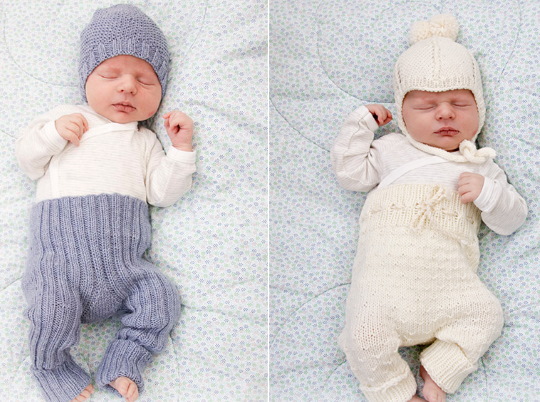
- To ensure that the garment fits well, it is essential to knit the gusset and gusset, as newborns wear diapers.
- The presence of an elastic band at the bottom of the product will be a big plus. It will ensure a tighter fit of the pants to the baby's legs, which will help keep the baby warm.
- The top of the product is finished with an elastic band. To make the pants fit better, you can use a drawstring or insert a wide elastic band inside that will not put pressure on the baby's stomach.
- Beads should not be used as decorations. They will interfere and cause discomfort to the child, which will affect his well-being.
The choice of model is influenced by the season for which the product is intended. Trousers with an openwork pattern are quite suitable for summer, and for the cold period, a garter stitch or garter stitch will do. A braid, aran or cord pattern can be placed in the center of the trousers. Children's trousers can be decorated with embroidery.
Tips for choosing yarn
After choosing a model, you need to select yarn for making the new thing. This stage should be approached responsibly, because not only comfort, but also the health of the baby depends on the choice of material.

It is better to knit pants for a newborn baby 0-6 months from yarn with the following properties:
- softness;
- hypoallergenic;
- thermal conductivity;
- hygroscopicity.
Natural yarn composition is a good choice, but wool is not suitable for all children. Wool yarn is prickly, irritating and itching the delicate skin of a child. Therefore, mixed yarn, which includes acrylic, is often used for children.
Acrylic threads add softness and are quite suitable for sensitive skin. VITA Briliant, VITA Sapfir, Alise baby wool, Gazzal baby wool, Pekhorka "Children's caprice" are the most common blended yarns.
Many mothers prefer knitted products for their children made of merino wool. Merino is a special breed of sheep, their wool is hypoallergenic and does not cause allergic reactions in babies. The disadvantages of yarn are its price. The cost of a 50 g skein is from 250 rubles. BBB Record, BBB Premier, Australian merino from Pekhorka are perfect for knitted pants.
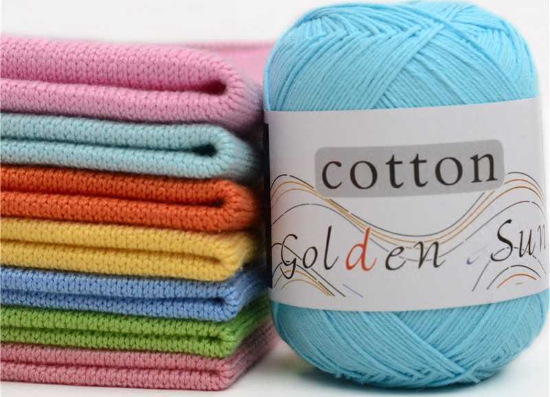
For the summer or warm off-season, you can use cotton yarn. Pure cotton yarn is rough to the touch, so it is also recommended to use a mixed composition or cotton that has undergone a special treatment - mercerization.
The price tag for this type of yarn is small, the color range is varied, the yarn is soft and pleasant to the touch. The child will feel comfortable and convenient.
Cotton yarn is available from many manufacturers, Gazzal baby cotton, children's cotton from Pekhorka.
You should not use 100% acrylic yarn for knitting children's items. Synthetic yarn does not warm and creates a "greenhouse effect". Yarn with long pile, such as angora, mohair, etc., is not suitable for babies.
Necessary materials and tools
Having decided on the yarn for the chosen model, you need to prepare the necessary tools.
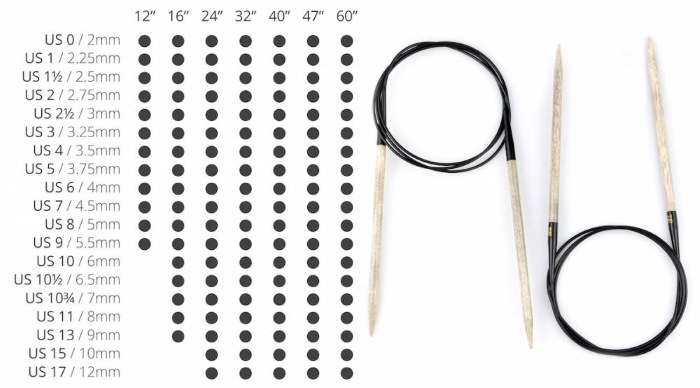
Pants for newborns 0-6 months are knitted with the following tools:
- circular knitting needles on 80 cm cord, with a diameter corresponding to the knitting density;
- a set of 5 double pointed needles of the appropriate diameter;
- hook;
- measuring tape;
- needle;
- wide elastic band, if required by the model;
- markers;
- scissors.
Measurements, calculation of knitting density
To knit the pants you will need the following measurements:
| Waist circumference | Step height | Seat height | Length of product | |
| 0-3 months | 44 cm | 13 cm | 15 cm | 34 cm |
| 3-6 months | 46 cm | 14 cm | 16 cm | 36 cm |
Before starting work, you should knit a sample of approximately 15 by 15 cm to determine the knitting density. The resulting sample is washed and dried.
Using a ruler or a measuring tape, count the number of loops in 10 cm horizontally and vertically. Then divide the resulting number by 10. This is how you get the knitting density. Based on these indicators, calculate the number of loops needed to knit the product.
Example:
- in 10 cm 20 loops horizontally. Knitting density: 20/10=2 horizontally;
- in 10 cm 20 loops vertically. Knitting density: 20/10=2 vertically.
Seamless option
Pants for newborns with knitting needles 0-6 months are knitted mainly in a seamless way. There are two ways: from the top and from the bottom. Below are the options in more detail.
Knitting pants from the top
First, you need to decide on the number of loops needed to start knitting. To do this, we will make the following calculations. Multiply the waist circumference by the knitting density and add 3 cm for ease of fit. Let's look at a specific example.
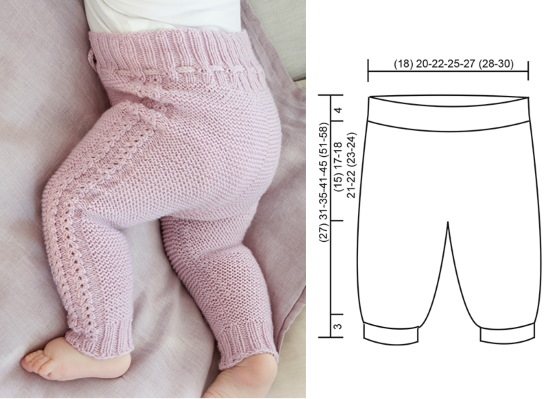
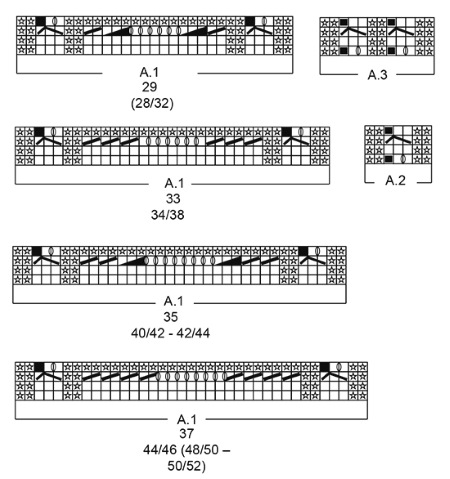
Cast on using circular needles:
- (0-3 m) 44*2+3*2=94 loops 1 loop for closing around 95 loops
- (3-6 m) 46*2+3*2=98 loops+1 loop for closing around 99 loops
We close the loops in a circle and knit an elastic band about 3 cm wide. There are many options for knitting elastic bands.
Let's look at some of them:
- Knitting elastic by alternating front and back loops 1x1 or 2x2.
- Knitting a hollow elastic band, which allows you to insert a drawstring inside, or a wide elastic band, so that the pants will not fall off the baby.
In the first case, you need to make a hole for the lace. So, the loops are cast on, the knitting is connected in a circle, we hang a marker to determine the beginning of the row, and knit 4.5 cm with face loops.
We divide the knitting in half, determine where the holes for the lace will be - pcalculations:
- (0-3 months) 94/2=47 loops, 47-1=46; 46/2=23; 23-2=21
- (3-6 months) 98/2=49 loops, 49-1=48; 48/2=24; 24-2=22
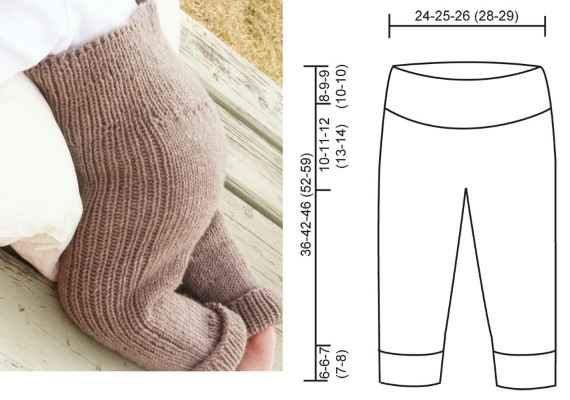
Explanations: 1 loop is the central one, we find the middle, we step back 2 loops from the middle - this is the distance between the holes.
After receiving the calculations, we proceed to knitting the next row:
- Knit 20 (21) loops, then knit 2 loops together, make a yarn over, knit 5 loops, make a yarn over, knit 2 loops together, 20 (21) loops, hang a marker, thus separating the front part of the pants from the back, knit the remaining loops to the marker.
- In the next row, the yarn overs need to be knitted so that a hole for the lace is formed. Knit another 1.5 cm in stockinette stitch.
- If you plan to use a wide elastic band instead of a lace, then in this case, holes are not made, but a 6 cm high stockinette stitch is knitted.
- Now you need to connect the beginning of the knitting with the loops on the knitting needle to get a hollow elastic band, into which the lace will be inserted later. To do this, knit one loop from the knitting needle together with the loop pulled out from the beginning of the knitting. Knit in this way to the end of the row.
- If you plan to insert an elastic band inside the belt, then the last few loops are not connected to the beginning of the row in order to leave an opening through which the elastic band can be threaded.
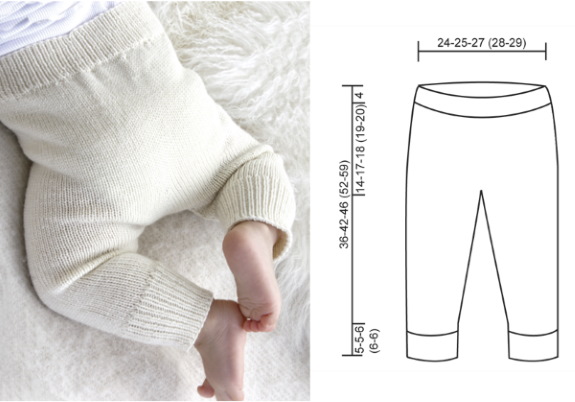
- When all the loops are connected, we proceed to knitting the sprout. The sprout for newborns is made approximately 2-3 cm. The knitting density vertically is multiplied by the height of the sprout, and thus the number of turning rows for its knitting is obtained.
- Calculations: 3cm*2=6.
- We divide the number of turning rows by 2, we get the number of turning points of knitting. In this case, there are 3.
- Knit 47 (49) front loops to the marker - these are the back loops, then 2 more front loops after the marker and turn the knitting.
- We remove the first loop and pull it away from us by the thread, so that a double loop is formed on the knitting needle, in other words, we wrap the thread away from us around the knitting needle and knit a row of purl loops to the marker, after the marker we knit 2 more purl loops and turn the knitting.
- Remove the first loop again and now pull the thread towards you to form a double loop on the knitting needle. Knit with face loops until you get a double loop. Knit the double loop with a face loop, picking up the thread from below, then knit 2 more face loops and turn the knitting.
- Knit to a double loop, which must be knitted purlwise, but the thread must be picked up from below, that is, the knitting needle is inserted from the bottom up, knit 2 more loops, make a turn. Make 2 more turning points on both sides, the distance between the points is 2 loops. The sprout is ready.
Now you need to determine the center of the front and back parts, marking it with a marker.
Along the central loops on the front and back, increases are made every 1.5 cm. Thus, approximately 13 (14) cm are knitted - this is the height of the step. Next, the gusset is knitted. The gusset is a kind of triangle in the front and the same in the back.
To knit it, you need to make increases in every second row from the central loop, forming a triangle, the apex of which is the central loop, and at the base there should ultimately be 7-9 loops. We remove the gusset loops onto an additional knitting needle or thread.
Next, we divide the knitting into separate legs. We transfer the loops to double-pointed needles and knit in a circle with the front surface of the leg length without taking into account the elastic band, if desired, you can make decreases. The length of the leg is calculated as follows: the length of the product minus the height of the step 34 (36) - 13 (14) = 21 (22), from the result we subtract the height of the elastic band, approximately 5 cm. We get approximately 16 (17) cm.
In the next row, you can make uniform decreases so that the elastic is narrower and fits better to the leg. To do this, after every 3 loops, you need to knit 2 loops together with the front one, calculate the decreases so that the number of remaining loops is a multiple of 2.
Then we knit a 1x1 elastic band 5 cm high, close the loops in any way. We knit the second leg using the same algorithm. We connect the remaining loops of the gusset with a needle using a loop-to-loop stitch. The pants are ready, all that remains is to thread the elastic band or lace, which can be crocheted from air loops.
Knitting pants from the bottom
Each leg is knitted separately on 5 double pointed needles:
- Cast on 36 stitches, close the knitting in a circle, hang a marker to mark the beginning of the row, and knit a 1x1 elastic band.
- Knit about 5 cm. Then move to the front surface, make increases every 3 loops. Knit 16 (17) cm.
- Now you need to make increases for the gusset, for this, at the beginning of the row marked with a marker, make a yarn over, and at the end of the row before the marker, also make a yarn over, thus, both from the front part of the leg and from the back part, the number of loops increases. Increases are made in each row. So 3 rows are knitted.
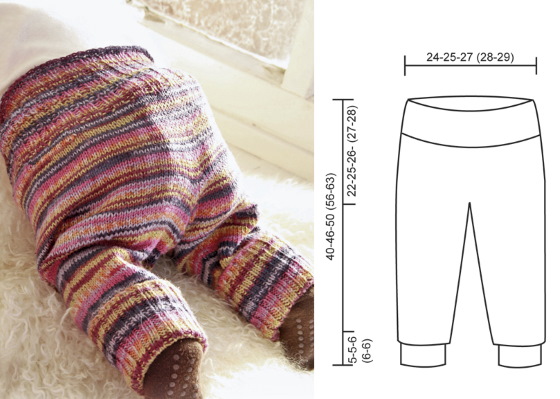
When both legs are ready, you need to connect the knitting. We transfer the loops of one leg to circular knitting needles, pick up additional loops for the gusset, 4 loops for the front part, and 4 loops for the back part, then we also remove the loops of the second leg onto the same knitting needles, and close the knitting in a circle. We knit in a circle 13 (14) cm. The loops, picked up additionally, at the end of the work will need to be connected with a needle.
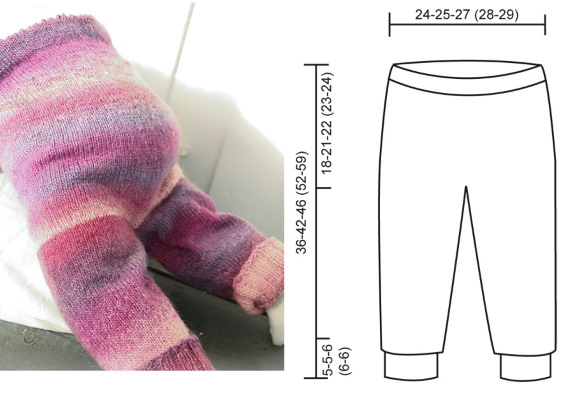
Next, knit a sprout along the back of the pants. When the sprout is ready, knit an elastic band, about 5 cm long. You can also finish the product with a hollow elastic band, so that it is possible to insert a lace or a wide elastic band inside. For this, knit a double width of the belt, if holes are planned, make them in the middle. Then, the open loops are sewn with a horizontal knitted seam.
With seam
Pants for a newborn with knitting needles 0-6 months can be knitted using a method that involves sewing 2 parts. In this case, to connect them, you need to choose a seam that is not too tight, so as not to cause discomfort to the baby.

Knitting:
- Knitting starts from the bottom. We cast on 36 loops. And knit 5 cm of elastic in turning rows.
- Next, we make even increases every 3 loops. We knit 16 (17) cm with the front surface, you can make increases if you plan to narrow the pants at the bottom.
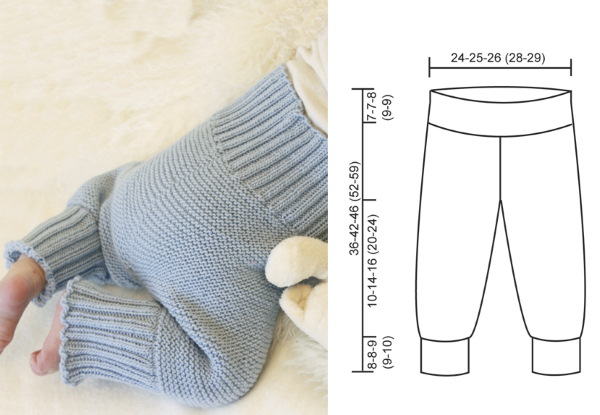
- Then increases are made for the gusset in each row at the beginning and at the end. So we knit 5 rows.
- Then we knit again with the front surface, making decreases along the front part of the leg, one loop every other row, thus making decreases 3 times.
- Next, knit with the front surface. The height from the beginning of the decreases to the top of the product is 13 (14) cm. Leave the loops open.
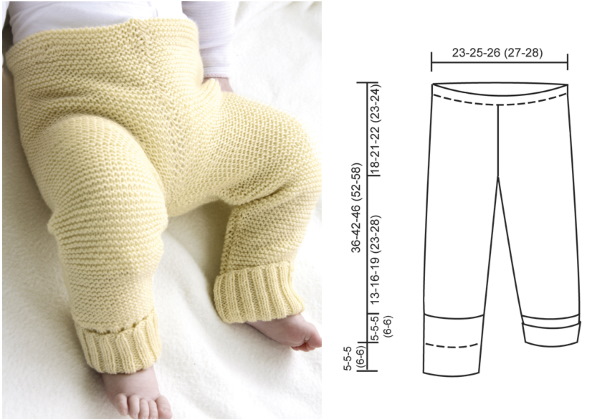
The second part is knitted using the same principle. Then we sew the legs separately, then join them together. We transfer the open loops to circular knitting needles. We knit a sprout along the back of the pants. Then we knit an elastic band or a belt in a circle.
Openwork model
The openwork model of pants is suitable for the summer period, it is knitted mainly for girls. For this model, there is no need to make a narrowing at the bottom, the best option would be a wide, spacious model, on the side of the leg, an openwork pattern is knitted, which the craftswoman liked the most.
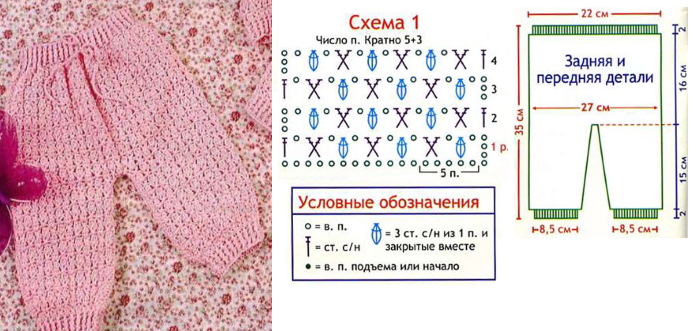
This model can also be knitted in the ways described above. It is best to decorate the bottom of the product with some pattern or garter stitch so that the front surface does not curl. You can close the loops in any convenient way.
Knitted overalls pants
The pants do not fall off the baby, as they are fixed, and the back will always be closed, which is very important in the first 0-6 months. Therefore, this model is very convenient for newborns. There are a large number of knitted versions of this model.
Let's look at one of them:
- Knitting starts from the waist down and then from the waist up.
- For this model, cast on 95 (99) stitches using waste yarn.
- Knit (18) 20 cm with stocking stitch, then knit the gusset.
- When there are 7-9 loops at the base of the gusset, we transfer them to an additional knitting needle.
- Divide the knitting into 2 legs. Transfer the stitches to double pointed needles and begin knitting 16 (17) cm.
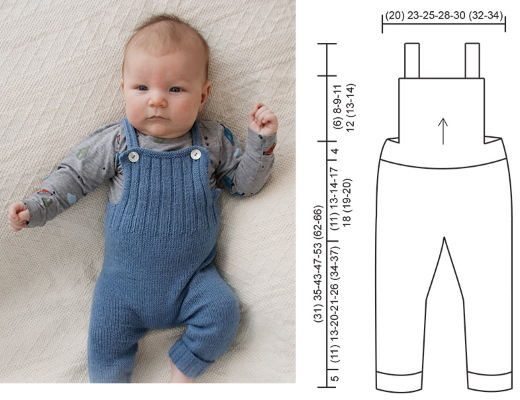
- We finish the bottom with an elastic band.
- We knit the second leg in the same way. We connect the gusset loops with a loop-to-loop seam.
- Let's go back to the beginning of knitting. Remove the waste yarn, transfer the open loops to circular needles.
- Find the middle of the front part of the pants, hang a marker. From the middle in 2 directions measure approximately 9 cm, if in loops, then this is 18 loops in different directions and mark them with markers. This will be the bib. It can be knitted with the front surface, as well as any pattern you like.
- The remaining loops are knitted with a rib. We knit about 5 cm of rib and a bib in a circle, then after the knitted loops of the bib, we close the loops of the rib in any convenient way and knit only the bib. Its height is about 15 cm, depending on the model, the height can be changed, made a little lower or vice versa.
The next step is knitting the straps. They can be made removable or knitted from the bib loops. The width of the straps and their length are calculated by trying them on. At the end of the straps, it is necessary to make a hole for buttons. The last stage in the manufacture of any knitted products is wet-heat treatment.
Knitted pants for newborns must be washed in warm water using liquid detergents suitable for babies 0-6 months.
Rinse in warm water to avoid damaging the yarn. Dry the item horizontally, spreading it out on a light cotton cloth.
Video about knitting pants for newborns
Knitted pants for newborns:
